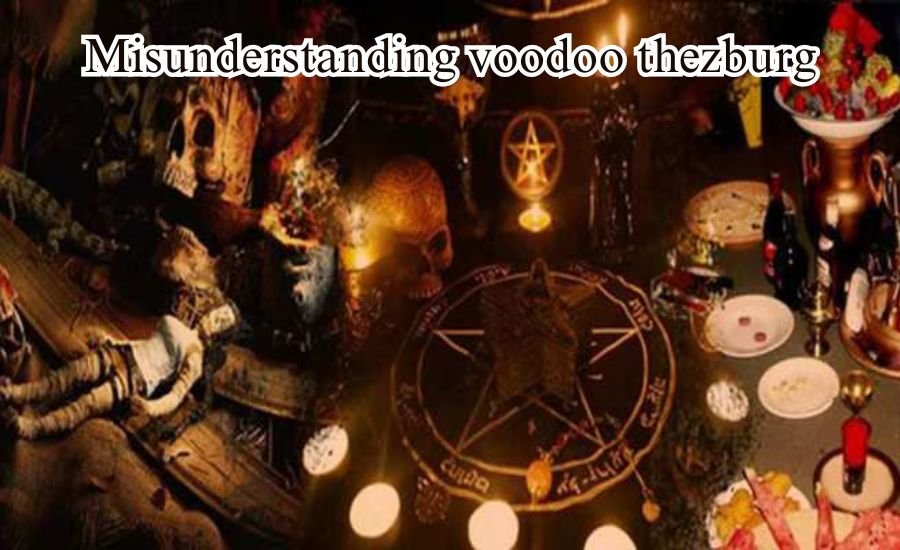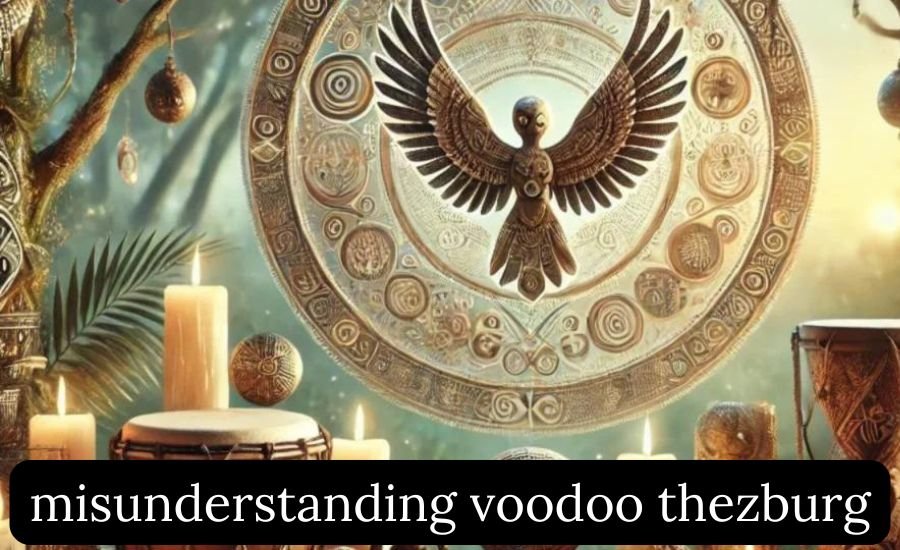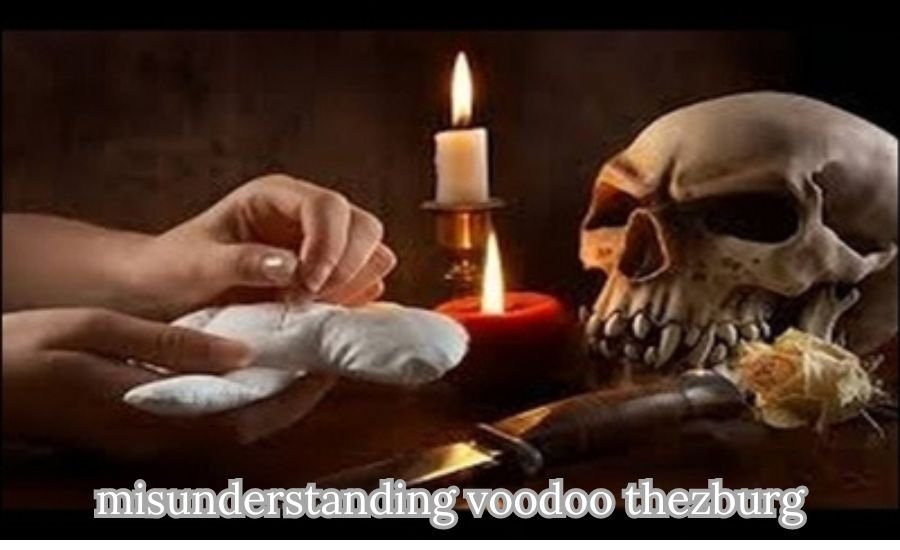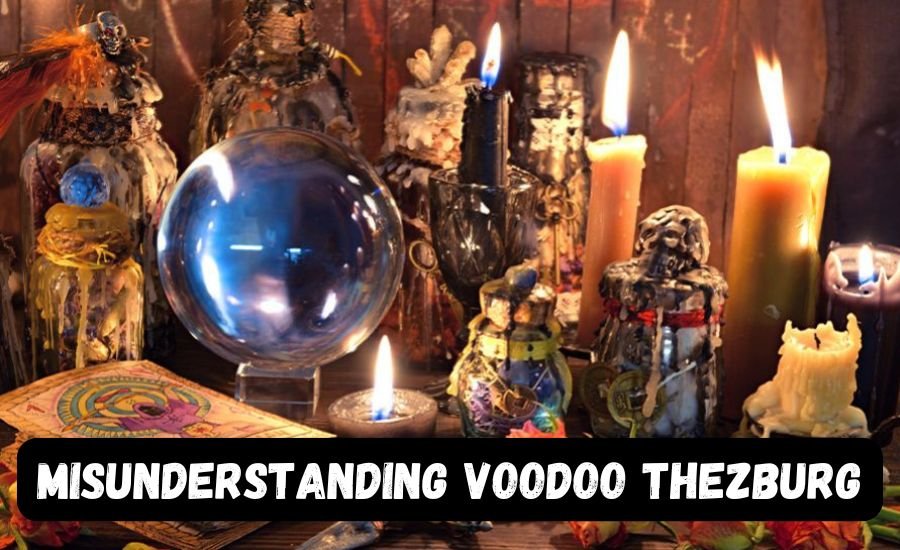The misunderstanding voodoo Thezburg is something that many people encounter. This confusion often comes from mixing up different spiritual practices that have unique origins and meanings. Voodoo, also known as Vodou, is a rich and complex religion with roots in West African traditions, while Thezburg is a distinct spiritual practice from Eastern Europe. Both have their own history and beliefs, but they are often misunderstood and misrepresented.
In this blog post, we’ll clear up the misunderstanding voodoo Thezburg and explore what makes each practice unique. We’ll discuss common myths, highlight key differences, and offer insights into the true nature of these spiritual traditions. By the end, you’ll have a better understanding of Voodoo and Thezburg, and how to appreciate them accurately.
What is Voodoo? Understanding the Basics
The misunderstanding voodoo Thezburg often starts with a lack of accurate information. Voodoo, or Vodou, is a religion that combines West African spiritual practices with elements of Christianity and local beliefs. This misunderstanding voodoo Thezburg is commonly fueled by the myths seen in movies or sensational media.
In Voodoo, people worship spirits known as “loa” and honor their ancestors through various rituals. These rituals include music, dance, and offerings to seek guidance and protection. Understanding Voodoo in its true context reveals it as a practice of community and healing, not dark magic.
Recognizing the real essence of Voodoo helps clear up the misunderstanding voodoo Thezburg and stop the spread of harmful myths about its practices.
Exploring Thezburg: What You Need to Know
The misunderstanding voodoo Thezburg often leads to confusion between the two practices. Thezburg is a spiritual tradition from Eastern Europe that involves nature worship and ancestral veneration. Unlike Voodoo, which has roots in West Africa and the Caribbean, Thezburg is deeply connected to Eastern European cultural practices.
In Thezburg, practitioners honor nature spirits and celebrate seasonal changes through specific rituals. These rituals reflect a deep respect for the natural world and its cycles. Understanding Thezburg helps clear up the misunderstanding voodoo Thezburg and highlights its unique traditions and beliefs.
Addressing the misunderstanding voodoo Thezburg by comparing it with Voodoo reveals the distinctiveness of each practice and their cultural significance.
Misunderstanding Voodoo and Thezburg: Common Myths

The misunderstanding voodoo Thezburg often leads to the belief that they are the same or involve dark magic. This misunderstanding voodoo Thezburg is due to their portrayal in media and popular culture. However, Voodoo and Thezburg have distinct origins and practices.
Voodoo is frequently associated with curses and black magic, while Thezburg is wrongly viewed as witchcraft. In truth, both traditions focus on respect, community, and spiritual connection rather than harm or dark arts.
Clearing up these myths about Voodoo and Thezburg helps correct the misunderstanding and fosters a better understanding of these diverse spiritual practices.
Voodoo vs. Thezburg: Key Differences Explained
The misunderstanding voodoo Thezburg can often be traced to confusion about their origins and practices. Voodoo has its origins in West Africa and has evolved through interactions with Caribbean and American cultures. On the other hand, Thezburg comes from Eastern Europe and focuses on nature and seasonal cycles.
Voodoo involves rituals that honor spirits and ancestors unique to its cultural background. In contrast, Thezburg’s practices are centered around nature worship and celebrating seasonal changes. Understanding these key differences helps clarify the misunderstanding voodoo Thezburg and appreciate the unique aspects of each practice.
Myth 1: Voodoo and Thezburg Are the Same
One common myth is that Voodoo and Thezburg are the same practice. However, this belief is far from accurate. Understanding the differences between Voodoo and Thezburg is essential for appreciating their unique qualities.
- Origins and Cultural Context: Voodoo originated in West Africa and evolved in the Caribbean and Americas, combining African spiritual practices with indigenous and Christian beliefs. Thezburg, on the other hand, has its roots in Eastern European traditions, focusing on nature worship and ancestral veneration. Their distinct origins shape their practices and beliefs.
- Spiritual Focus: Voodoo centers around worshipping spirits called “loa” and honoring ancestors. These spirits are believed to provide guidance and protection. Thezburg focuses more on nature and the spiritual forces present in the natural world, emphasizing seasonal cycles and harmony with the environment.
- Rituals and Practices: In Voodoo, rituals often include music, dance, and offerings to the loa. These ceremonies are performed to seek blessings or healing. Thezburg rituals are primarily focused on celebrating nature’s cycles, such as the changing seasons, and involve ceremonies that honor the spirits of the land.
- Cultural Representation: Media often blends or confuses Voodoo and Thezburg, leading to misconceptions. Voodoo is frequently depicted with dark magic and curses, which is not an accurate representation. Thezburg is sometimes misunderstood as merely a form of witchcraft, whereas it emphasizes respect for nature and ancestors.
- Community and Identity: Voodoo plays a crucial role in the communities of Haiti, parts of Africa, and the Americas, where it is deeply integrated into daily life. Thezburg is a tradition practiced in rural Eastern Europe, reflecting local values and environmental respect.
- Diversity within Practices: Both Voodoo and Thezburg have diverse practices within their traditions. Voodoo varies significantly between regions like Haiti and New Orleans, while Thezburg also has regional variations depending on local customs and beliefs.
Understanding these differences helps to dispel the myth that Voodoo and Thezburg are the same, highlighting their unique cultural and spiritual significance.
Myth 2: Voodoo Involves Black Magic

One common misunderstanding voodoo Thezburg involves the belief that Voodoo practices black magic. This myth is perpetuated by sensationalist media portrayals, leading to a distorted view of Voodoo. In reality, Voodoo is about community, healing, and spiritual connection.
Voodoo rituals are meant to seek guidance and protection from spirits, not to cause harm. They include music, dance, and offerings to help individuals and their communities. Debunking the myth that Voodoo involves black magic helps reveal its true purpose and practices.
Myth 3: Thezburg is Just Like Other Pagan Practices
The misunderstanding voodoo Thezburg often leads people to believe that Thezburg is similar to other pagan practices. This misconception overlooks Thezburg’s unique traditions rooted in Eastern European cultural practices. While it involves nature worship, Thezburg has distinct rituals and beliefs.
In Thezburg, practitioners honor nature spirits and celebrate seasonal changes through specific rituals unique to their culture. These practices are different from other pagan traditions, which may have different focuses and methods. Understanding Thezburg’s unique aspects helps address the misunderstanding voodoo Thezburg.
How Media Misrepresents Voodoo and Thezburg
The misunderstanding voodoo Thezburg is often exacerbated by media misrepresentation. Movies and TV shows frequently depict Voodoo and Thezburg in misleading ways, contributing to myths and stereotypes.
Media portrayals often show Voodoo as involving dark magic or Thezburg as witchcraft, which distorts their true nature. Accurate representations in media can help combat these misconceptions and promote a better understanding of both practices.
The Truth About Voodoo Dolls and Their Uses
Many people think Voodoo dolls are used to harm others, thanks to movies and sensational stories. But this is not true. Voodoo dolls are actually part of a rich tradition with specific and positive uses.
In Voodoo, dolls are called “poupées” and are used to represent individuals during rituals. They are not tools for casting spells or causing harm. Instead, these dolls help focus spiritual energy for healing, protection, and guidance. Practitioners might use them to request help from spirits or to send good wishes to someone.
The dolls are often decorated with symbols, beads, and personal items to strengthen their connection to the person they represent. This helps in creating a positive and supportive spiritual environment.
Why Thezburg Focuses on Nature and Seasons

Thezburg places a strong emphasis on nature and the changing seasons because it views the natural world as deeply interconnected with spiritual life. For practitioners, nature is more than just a backdrop; it’s an essential part of their spiritual practice.
In Thezburg, the cycles of nature and the seasons are seen as powerful symbols of life’s rhythms. By aligning their rituals and ceremonies with the seasons, practitioners honor the natural flow of life and its changes. For example, spring is celebrated as a time of renewal and growth, while winter is a period for reflection and rest.
Focusing on nature also helps Thezburg practitioners maintain harmony with their environment. They believe that respecting and understanding the natural world leads to a balanced and fulfilling life. This connection to nature is reflected in their prac
Voodoo’s Rich Cultural Background: A Deeper Look
Voodoo is much more than the dark stereotypes often shown in movies. It has a rich and vibrant cultural background deeply rooted in West African traditions, particularly those of the Fon and Ewe people. When African slaves were brought to the Caribbean and the Americas, they carried their spiritual practices with them. These practices blended with local indigenous beliefs and elements of Catholicism, creating what we now know as Voodoo.
In Voodoo, worship revolves around spirits called “loa” and honoring ancestors. Rituals and ceremonies are central to the practice, focusing on community, healing, and spiritual guidance. Far from being a form of black magic, Voodoo is a complex and respectful belief system that plays a vital role in the lives of its practitioners.
Understanding Voodoo’s background helps to see it as a meaningful and sacred tradition rather than a source of fear or misunderstanding. It is a vibrant expression of cultural heritage and spiritual connection.
Thezburg’s Unique Traditions and Beliefs
Thezburg has a rich tapestry of traditions and beliefs that set it apart from other spiritual practices. This tradition, rooted in Eastern Europe, emphasizes a deep connection with nature and ancestral spirits.
In Thezburg, rituals often center around the changing seasons and natural cycles. Practitioners celebrate these changes with ceremonies that honor the spirits of the land. This includes offerings and dances designed to maintain harmony with the environment.
Ancestral veneration is another key aspect of Thezburg. People believe that their ancestors watch over them and can offer guidance and protection. Special ceremonies are held to honor these ancestors and seek their blessings.
Additionally, Thezburg practitioners focus on living in balance with nature. This belief guides their daily lives and interactions with the world around them. By respecting the environment and the cycles of nature, Thezburg followers aim to maintain spiritual and communal harmony.
Read More : Final Clue Oaklooon
How Misunderstandings Affect Practitioners
Misunderstandings about Voodoo and similar practices can have serious effects on practitioners. When people believe false stereotypes, it can lead to negative consequences for those who follow these traditions. For example, misconceptions can result in social stigma or discrimination, making it difficult for practitioners to openly practice their beliefs.
Practitioners may face isolation or judgment from others who do not understand their spiritual practices. This can create barriers to community involvement and personal expression. In some cases, misunderstandings can lead to outright hostility or aggression, which can be harmful and unjust.
Moreover, when Voodoo practices are misrepresented in media or popular culture, it distorts their true meaning. This misrepresentation not only impacts the practitioners’ reputation but also undermines their cultural and spiritual heritage. Respect and accurate knowledge are crucial to supporting practitioners and allowing them to practice their beliefs freely and without fear.
Respecting Voodoo and Thezburg in Popular Culture

In popular culture, Voodoo and Thezburg are often portrayed in ways that can be misleading or disrespectful. These portrayals can contribute to misconceptions and stereotypes, making it important to approach these spiritual practices with respect and understanding.
Voodoo is frequently depicted as dark or sinister, but in reality, it is a religion centered on healing, community, and spiritual connection. It involves honoring ancestors and seeking guidance from spirits, with a focus on positive and protective rituals. Similarly, Thezburg, which emphasizes nature worship and harmony, is sometimes misrepresented as witchcraft or sorcery. This can overshadow its true essence, which is about respect for the environment and seasonal cycles.
Respecting these practices in popular culture means presenting them accurately and sensitively. Avoiding sensationalism and focusing on their true cultural and spiritual significance can help foster a more informed and respectful understanding. By doing so, we contribute to a more inclusive and respectful representation of diverse spiritual traditions.
Personal Stories: Practitioners of Voodoo and Thezburg
Hearing personal stories from practitioners can shed light on the real experiences behind the misunderstanding voodoo Thezburg. For example, Marie, a Voodoo practitioner, shares her journey and how she navigates misconceptions about her faith. Similarly, Ivan, who practices Thezburg, talks about his connection to nature and the spiritual practices that are often misunderstood.
These personal accounts help bridge the gap between myths and reality, offering insights into the true nature of Voodoo and Thezburg. By listening to their stories, we gain a better understanding of these traditions and how to respect them.
This content is designed to be engaging and accessible while addressing misconceptions about Voodoo and Thezburg. If you need any further modifications or additional content, feel free to ask!
Conclusion
Understanding the misunderstanding voodoo Thezburg is important for respecting and appreciating these unique spiritual practices. Voodoo and Thezburg each have their own special traditions and meanings. By learning the truth and not believing the myths, we can see these practices for what they really are. This helps us build a world where everyone’s beliefs are respected.
Remember, clear information and open-mindedness are key to overcoming the misunderstanding voodoo Thezburg. If we take the time to educate ourselves and listen to those who practice these religions, we can help spread respect and understanding. Let’s work together to celebrate and honor all cultures and their rich traditions.
Do You Know: Del Bandito Mine Esmeralda NV History
FAQs
Q: What is the misunderstanding voodoo Thezburg about?
A: The misunderstanding voodoo Thezburg refers to the false beliefs and myths surrounding Voodoo and Thezburg, often portrayed inaccurately in media. It involves clearing up misconceptions and understanding these spiritual practices accurately.
Q: Is Voodoo in Thezburg a form of black magic?
A: No, Voodoo in Thezburg is not black magic. It is a spiritual practice focused on healing, community, and honoring ancestors, not causing harm.
Q: What are Thezburg practices focused on?
A: Thezburg practices focus on nature worship, ancestral veneration, and connecting with spirits in the natural world. It is distinct from Voodoo but shares some similarities in revering ancestors.
Q: How did Voodoo and Thezburg originate?
A: Voodoo originated in West Africa and was brought to the Americas, blending with local beliefs. Thezburg, on the other hand, comes from Eastern Europe and focuses on nature and ancestral traditions.
Q: Are Voodoo dolls used for harmful purposes?
A: No, in Voodoo practices, dolls are used to represent individuals for positive purposes such as healing and protection, not for harm.
Q: How can we correct misunderstandings about Voodoo and Thezburg?
A: To correct misunderstandings, educate yourself with accurate information, engage respectfully with practitioners, and avoid sensationalized media portrayals.
Q: Can non-practitioners participate in Voodoo or Thezburg ceremonies?
A: Yes, non-practitioners are often welcome to observe or participate in ceremonies, provided they approach with respect and a willingness to learn.



